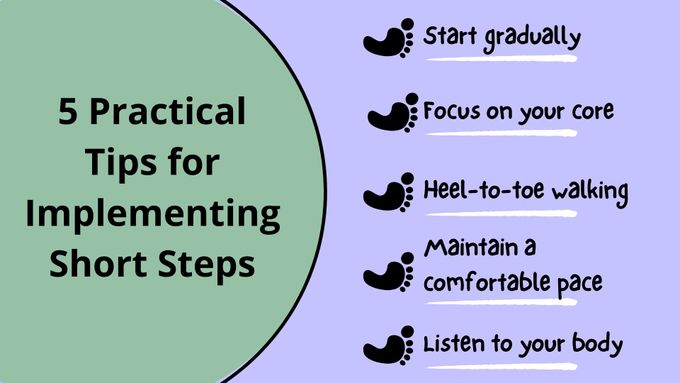Short Steps When Walking: Improving Your Walking Technique With Kids
Adopting a shorter stride length shows your commitment to self-care and injury prevention, ensuring a sustainable and enjoyable walking experience.
Updated December 6, 2024

Walking, a fundamental human activity, is often overlooked in its potential for promoting health and well-being. Yet, with a slight modification to how we walk—specifically, adopting shorter steps—we can significantly enhance the quality of our walks with our young children.
This approach bolsters our physical fitness and contributes to a sustainable, healthier lifestyle. Let’s explore why adopting short steps can be invaluable to anyone looking to improve their walking technique and overall health.
The Benefits of Short Steps
Improved Stability and Balance
Shorter steps naturally increase your stability as you walk, which is beneficial on uneven terrains or in slippery conditions where maintaining balance is crucial to preventing falls.
Also, taking shorter steps encourages a more controlled, back-and-forth arm swing. This minimizes wild arm flapping, which can waste energy and disrupt balance, thereby enhancing coordination and stability. This technique can empower older adults or those with balance issues, enabling safer, more confident mobility when walking with your family.
» Taking your kids outside? Be sure to check out our best waterproof shoes for children
Reduced Impact on Joints
Long strides can put undue stress on the knees and hips, leading to discomfort and potential injuries over time. Shortening your steps minimizes the force exerted on these joints with each footfall.
This gentle approach can alleviate pain and especially benefit individuals dealing with arthritis or recovering from joint-related injuries.
Better Body Alignment and Posture
Beyond improved stability, reduced impact, and increased efficiency, taking shorter steps also helps to improve body alignment and posture while walking, leading to better balance. Here's how:
- Improved core engagement: Taking shorter steps engages the core muscles more. These muscles help keep the spine in a neutral, aligned position, preventing slouching and promoting better posture. Good core engagement also improves balance by stabilizing the torso and pelvis.
- Enhanced foot placement: With smaller steps, the foot lands closer to the body's center of gravity than the heel or ball. This balanced foot placement distributes pressure evenly, preventing the ankles from rolling inward or outward, which can contribute to instability and falls.
- Mindful movement: Focusing on taking shorter steps naturally increases awareness of body movement. This mindfulness makes it easy to identify and correct postural imbalances or deviations in real-time, promoting better overall alignment and balance.
» Keeping active with your kids? Make sure they've got some durable and supportive sneakers
How Walking Promotes Long-Term Joint Health
The reduced stride length associated with short steps means that the impact force of each step is distributed more evenly across the foot and leg muscles rather than being concentrated on the joints.
This ‘spread’ of force acts as a natural shock absorber, diminishing the wear and tear on your joints and promoting long-term health.
Short steps also promote a more efficient walking pattern, maintaining balance and stability. This efficiency is crucial for minimizing excessive rotation and sideways movement of the knees and hips, further protecting these joints from strain.
5 Practical Tips for Implementing Short Steps
1. Start Gradually
Adopting shorter steps should be approached gradually. Begin by slightly reducing your stride length and pay attention to how it feels. Avoid making drastic changes that could feel unnatural or cause discomfort.
2. Focus on Your Core
Remember to engage your core muscles as you walk. This not only aids in maintaining good posture but also helps in stabilizing your steps. A strong core is the foundation of efficient, healthy walking.
3. Heel-to-Toe Walking
Ensure your heel touches the ground first, rolling through to your toes with each step. This technique promotes natural shock absorption and minimizes stress on the lower leg muscles.
4. Maintain a Comfortable Pace
Initially, don’t worry too much about speed. Focus on the quality of your steps and maintaining a comfortable pace. As you become more accustomed to shorter steps, you can gradually increase your walking speed while retaining the technique’s benefits.
5. Listen to Your Body
As with any change in physical activity, it’s crucial to listen to your body and adjust accordingly. If you experience discomfort or fatigue, take a step back and reassess your technique. Over time, your body will adapt, and the benefits of shorter steps will become more apparent.
» Discover the differences between regular and supportive kids' shoes
Master the Art of Walking
Take the first step towards a healthier you by shortening your stride and discovering the significant difference it can make to your walking experience. This adjustment allows walkers of all ages and fitness levels to enjoy the numerous health benefits of a more mindful, aligned, and efficient walking style.
Additionally, if you're a parent looking for a way to make walking a bonding activity with your kids, explore our collection of orthopedic shoes for them to enhance this experience. These shoes are designed to support healthy walking habits from a young age.






